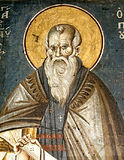 Hieromartyr Hierotheus, bishop of Athens (1st c.).
Hieromartyr Hierotheus, bishop of Athens (1st c.).  Uncovering of the relics (1595) of St. Gurias, first archbishop of Kazan, and St. Barsanuphius, bishop of Tver (1595).
Uncovering of the relics (1595) of St. Gurias, first archbishop of Kazan, and St. Barsanuphius, bishop of Tver (1595).  Synaxis of the Saints of Kazan.
Synaxis of the Saints of Kazan.
Martyrs Gaius, Faustus, Eusebius, and Chaeremon, of Alexandria (3rd c.). Hieromartyr Peter of Capitolia, bishop of Bostra in Arabia (715). Martyrs Domnina and her daughters Berenice (Bernice) and Prosdoce, of Syria (302). Martyr Adauctus (ca. 312) and his daughter St. Callisthene (ca. 318), of Ephesus. Sts. Paul the Simple (ca. 339) and Ammon (350), of Egypt, disciples of St. Anthony the Great. St. Vladimir Yaroslavich, prince of Novgorod (1052), and his mother St. Anna of Novgorod (1050). Sts. Helladius and Onesimus of the Near Caves in Kiev (12th c.-13th c.). St. Ammon, recluse, of the Far Caves in Kiev (13th c.). St. Stephen Stiljanovic, despot of Srem, Serbia (1540) and his wife St. Helen (Elizabeth in monasticism) (ca. 1543). Sts. Jonah and Nectarius, monks, of Kazan (16th c.).
New Hieromartyrs Basil (Tsvetkov), archimandrite, of Stary Kelets (Ryazan) and Tikhon Arkhangelsky, archpriest, of Kuiman (Voronezh) (1937). New Hiero-confessor Barsanuphius (Yurchenko) of Kherson (1954).
St. Theodore the Wonderworker, bishop of Tamassos, Cyprus (2nd c.). Hieromartyr Peter of Capitolia, bishop of Bostra in Arabia (715). St. John (Lampadistes) of Cyprus (10th c.). Hieromartyr Evdemoz, catholicos of Georgia (1642).
Thursday. [Phil. 3:1-8; Luke 7:17-30]
Saint John the Forerunner sends his
disciples to ask the Lord: is He the One That should come?
Or should they look for another? He did not ask this for
himself but for his disciples, for he knew precisely who
Jesus Christ was, being informed about this from heaven.
The disciples sought an answer to this question not out of
empty inquisitiveness, but out of a sincere desire to know
the truth. To such as these there is no need to say much;
the Lord does not speak, only indicates what had been
accomplished by Him at that time. Divine deeds witnessed
to His divinity. It was so obvious, that the questioners
no longer questioned. This is the way it always is. The
power of God lives in the Church; a sincere seeker of the
truth immediately feels it and is sure of this truth. This
sureness through experience puts an end to all questions
and completely soothes. He who does not want to believe,
and, having lost his faith, begins to seek in the Church
and Christianity not the foundations of faith, but grounds
to justify his unbelief, will find no indications
satisfactory. He considers his unbelief well-grounded,
although its foundations are petty and insignificant. His
heart wants this—that is why it is all
tolerable.


![]() Hieromartyr Hierotheus, bishop of Athens (1st c.).
Hieromartyr Hierotheus, bishop of Athens (1st c.). ![]() Uncovering of the relics (1595) of St. Gurias, first archbishop of Kazan, and St. Barsanuphius, bishop of Tver (1595).
Uncovering of the relics (1595) of St. Gurias, first archbishop of Kazan, and St. Barsanuphius, bishop of Tver (1595). ![]() Synaxis of the Saints of Kazan.
Synaxis of the Saints of Kazan. 


















